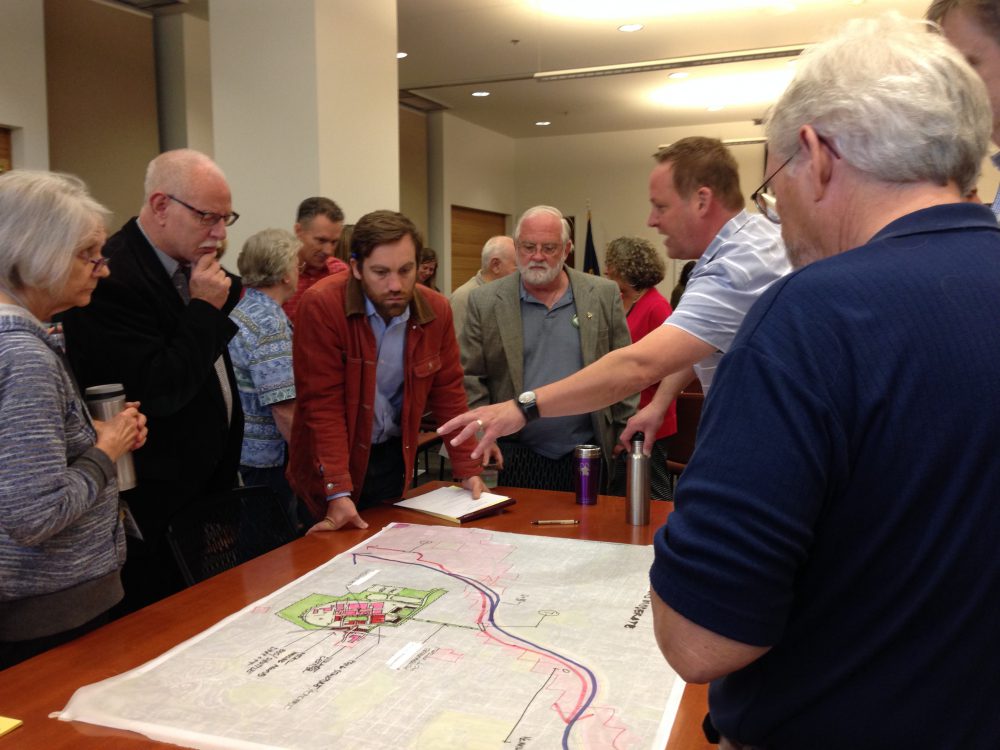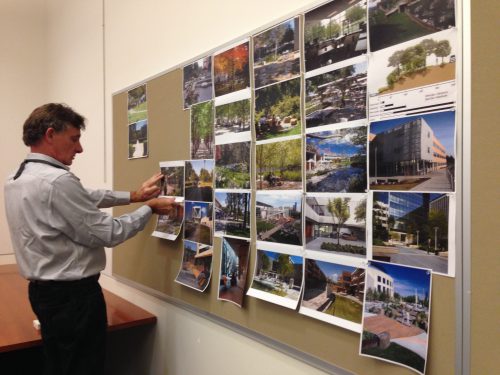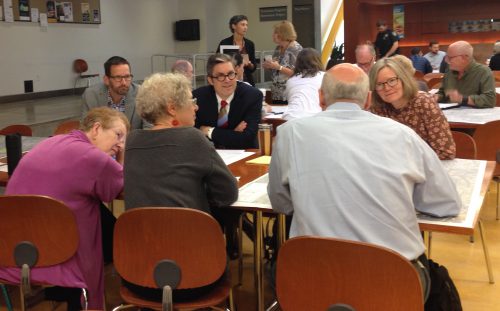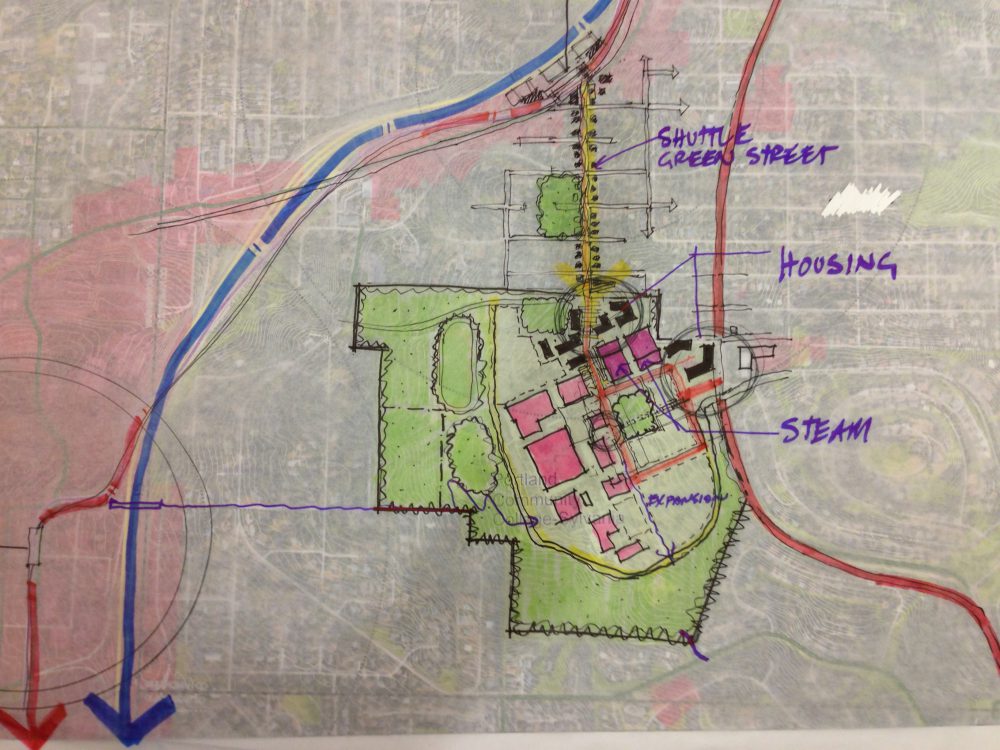This content was published: November 23, 2016. Phone numbers, email addresses, and other information may have changed.
Sylvania community hosts visioning event to plan for growth, opportunities
Photos and story by Katherine Miller
 Portland Community College is looking – and planning – ahead. Sylvania Campus recently held a two-day “visioning” event to explore the opportunities and challenges that are likely to impact the campus community during the next 25 years as the greater metropolitan area continues its dramatic growth.
Portland Community College is looking – and planning – ahead. Sylvania Campus recently held a two-day “visioning” event to explore the opportunities and challenges that are likely to impact the campus community during the next 25 years as the greater metropolitan area continues its dramatic growth.
The more than 120 attendees included faculty, staff, students and board members from the college; representatives from two neighborhood associations, plus Metro, TriMet, the cities of Portland, Lake Oswego and Tigard; as well as several architecture firms that have worked extensively with PCC.
The event was spurred on by Metro’s Southwest Corridor Plan Steering Committee, which is gathering information and ideas from stakeholders as it identifies a range of transportation options for southwest Portland and southeast Washington County, including light rail, bus transit, and bicycle, roadway and pedestrian improvements.
Over the next 12 to 15 months, a federal environmental review period will assess the potential impacts of the Southwest Corridor Plan and assist in the selection of a final package of transportation investment.

The visioning event will help inform master planning work for Sylvania’s academic programs, facilities, technology and other services.
But the visioning event was also intended to help guide the entire college and its board of directors as it embarks on substantial strategic planning efforts for academic programming, facilities, technology and other services. It will also help inform the discussion about a future bond measure.
“This event represents a serious commitment to involve and listen to our community – both internal and external – as we plan the future of our region,” said PCC’s Executive Vice President Sylvia Kelley. “It demonstrates the dedication we all share as we find better ways to serve our students, while ensuring that we focus on maintaining vibrant surrounding communities.”
The projected growth of the region was a major focus of the event. Malu Wilkinson, investments area manager at Metro, told attendees that by 2040, the Portland metropolitan area will add 400,000 new residents and 280,000 new jobs. The Southwest Corridor is likely to be the destination for as many as 48 percent of those residents and 38 percent of the jobs, she said.
Another key topic raised at the event was healthcare, a popular career path for many PCC students. Jennifer Piper, division dean for Health Professions, Early Education & Family Studies, Physical Education & Fitness Technology, said medical errors are now the third leading cause of death in the U.S. and chronic diseases are soaring to an all-time high. Solving these problems will require the U.S. to move from a “sickness-based” healthcare system to a “wellness, patient-centered, integrative-care model,” which will require the college to shift academic programs and resources to an interprofessional training approach.
“For decades, we have been training excellent healthcare professionals within their scope of practice,” Piper said. “The goal of interprofessional education, and the vision of what good patient care looks like in the future, is to flatten the hierarchy and empower every healthcare professional to work collaboratively for patient-centered, integrative care. Keeping our eye on what the future needs are for our community and workforce is the key to our vitality and the health of our community in the years to come.”
After presenters shared their remarks, attendees gathered in several smaller groups to brainstorm how the college could purposefully grow to better serve students, faculty, administration, staff, business owners, and Sylvania neighborhoods. Their recommendations proved to be wide-ranging yet were typically linked by the theme of accessibility. They included:
- On-campus housing for students and perhaps even faculty: This was in response to the long commute times faced by many who study or work at Sylvania, as well as the high cost of rental housing in the larger community;
- A childcare center, which might also offer respite care for PCC students who are the primary caregivers for aged parents;
- Transportation that would take people up and down the hill between the proposed light rail station at Southwest 53rd Avenue and Sylvania Campus;
- Multi-level parking structures, which would create space on campus for new construction;
- Better communication with Sylvania neighbors to ensure good relations and encourage campus visits for things such as cultural events and continuing education classes;
- More affordable food options on campus;
- Improved way-finding signage.
Architects collected the groups’ recommendations and on the second day presented drawings of four scenarios for campus development, ranging from “baseline” to most “progressive.” Attendees spent time examining the plans and shared their reactions with the architects, who then collected the comments and presented them to the larger group.

Attendees broke out into smaller groups to brainstorm ideas for long-range growth at Sylvania Campus.
PCC Board member and former chair Denise Frisbee said that the information gathered, “will get in-depth attention in the college’s district-wide academic master planning and facilities planning, and help us plan further out in response to regional demand and infrastructure improvements. In the more immediate time frame, our visioning exploration will help us take advantage of some of our options to improve not only transportation but the larger college experience for our students and staff that the Southwest Corridor project presents.
“We in Oregon know that it is always better to plan for growth than just let growth happen and the Sylvania visioning event gave us the chance to start the conversation,” she continued.
Meanwhile, Russ O’Connor, vice president of the Mountain Park Homeowners Association, commended PCC for considering different options for long-range growth, but he urged the college not to settle for the most cautious approach.
“Visioning and producing a master plan for 25 years needs to fall in the ‘progressive arena otherwise you may curtail or come up short on what it could’ve been if a moderate or baseline vision was chosen,” O’Connor said. “In other words, ‘go big and shoot for your dreams’ and be positive for the future. You can always make changes along the way, and 25 years is a very long time.”
Chelsey Effinger, a first-year architectural drafting student at PCC, appreciated the visioning event’s “high level of professionalism” in eliciting ideas and concerns and incorporating the attendees’ recommendations into the campus drawings.
“Students should be a part of the vision of the future,” said Effinger. “While we are here, this campus is our community, our family and after we graduate, I want Sylvania Campus and PCC in general to be a place the community is proud of and students look forward to attending. Ways for this to happen are through comfortable spaces, easy navigation to and from and within campus, clear communication of where buildings are, and where to find student services.”



This is a good start, but I don’t see anything described that includes sustainability. PCC needs to be a better leader. 25 years is a very SHORT time. We should always include aiming for net-zero everything. Without that goal we will run out of resources. Net-zero carbon. Net-zero water. Net-zero wastes. Not for show but for real.